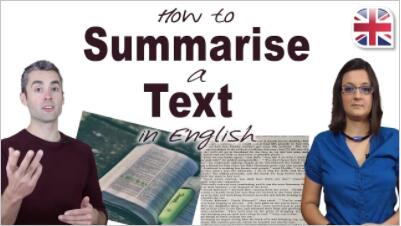Hi, I'm Oli. Welcome to Oxford Online English!
大家好,我是奥利。欢迎来到牛津在线英语课堂!
In this lesson, you can learn how to read and summarise a text.
在这节课中,大家将会学习如何阅读和总结一篇文章。
Summarising a text is a vital skill for your English reading.
总结一篇文章对英语阅读来说是一项重要的技能。
If you can't make a short, clear summary of the main ideas of a text, then you almost certainly haven't understood it fully.
如果无法对一篇文章的主要思想做一个简短、清晰的总结,那么肯定的说,你没有完全理解文章。
Understanding what you read in English isn't just about the words; it's about understanding the ideas,
所谓理解不仅仅指文章的词汇;而是理解文章思路,
how they're organised, and which ideas are more or less important.
组织形式,以及筛选文中关键以及不关键的信息。

Here, you'll see some strategies you can use to improve your English reading, read faster, and improve your reading comprehension.
这堂课,将为大家展示一些策略,可以用来提高你们的英语阅读水平,阅读速度,以及提升阅读理解能力。
Before we begin, check out our website: Oxford Online English dot com.
课堂开始前,请浏览我们的网站:牛津在线英语网站。
Do you want to see a range of video and listening lessons to improve your English, all 100% free?
想不想看一系列完全免费的视频以及听力课程来提高英语水平?
We have that! Do you want to take online classes with a professional teacher?
来我们网站吧!你想参加专业教师的在线课程吗?
We can do that, too! Oxford Online English dot com.
我们的网站一应俱全!请浏览牛津在线英语网站。
In this lesson, we'll work with a sample text.
本节课,我们将学习一个示例文本。
You'll see it in the video, but you can also find it on the full version of this lesson, which is on our website.
接下来将在视频中为大家展示,你们也可以到我们网站上的完整版本中搜索。
You can find a link in the video description.
视频简介中为大家提供了链接。
We recommend reading it before you continue watching.
我们建议您在观看视频之前先阅读一下。
Now, let's look at the most important reading strategy you need to use.
现在,我们来看看大家需要使用的最重要的阅读策略。
To understand and summarise a text, you need to find the main idea.
要理解和总结一篇文章,需要找到文章的中心思想。
Every coherent text has one central idea, which connects the different parts of the text.
每一篇连贯的文章都有一个中心思想,连接着文章的不同部分。
You need to know what this is.
你需要寻找中心思想。
But, every text is different, and there isn't one way to find the main idea.
但是,每篇文章都是不同的,所以寻找主旨的方法也多种多样。
Instead, you need to look at the whole thing.
注意,你需要通观全文。
Here are some things you should look at: One: is there a title or headings?
你要注意的事情有:第一:有标题吗?
These will often highlight the most important points.
这些标题通常会突出最重要的信息。
Two: what is the first sentence about? Often, the first sentence of a text or paragraph will summarise the main ideas.
第二:第一句话讲的是什么内容?通常,一篇文章或一段话的第一句话会概括大意。
Three: what does most of the text talk about? Look at each sentence and paragraph.
第三:课文大部分都在讲什么内容?浏览每个句子和段落。
Is there a single topic which connects them? Look at our sample text and think about these questions.
是否有一个单一的主题将文章联系起来?观察我们的示例文本,并思考这些问题。
Pause the video if you need more reading time, and remember that you can also read it on our website—
如果需要更多时间阅读,请暂停视频,你也可以到我们的网站上阅读——
just follow the link in the video description.
点击视频描述中的链接即可。
So, what do you think the main idea of our sample text is? We'll show you three possible summaries.
那么,你认为示例文本的主旨是什么?我们将展示三种可能的总结示范。
Which do you think is best? What do you think? The best is number three.
你认为哪个总结最佳?你觉得怎么样呢?第三个是最佳答案。
Let's see why. First, you should look at the title.
我们来分析一下原因,首先,你可以看下标题。
The title tells you that the text will be about Guugu Yimithirr, but it also mentions that this language is ‘unusual'.
标题告诉我们,文章是关于Guugu Yimithirr语,但文章也提到这种语言是“不寻常”。
You should immediately focus on this word, because it shows that this language is different in some way.
你应该马上注意这一单词,因为它表明这门语言在某些方面是不同的。
Also, ‘unusual' could mean many things. What does it mean here? Unusual how?
还有,“unusual”可以有多种理解。这是什么意思?怎么个不同寻常?
Second, what's the first sentence about? Here, it gives background information.
第二,第一句是关于什么内容?而在此处,它提供了背景信息。
It doesn't help you to find the main idea.
寻找中心思想跟这个关系不大。
That's OK—in this case, the background information is helpful, because most people don't know what Guugu Yimithirr is.
不过没关系——在这种情况下,背景信息也是有用的,因为大多数人不知道Guugu Yimithirr是什么。
Third, what does most of the text talk about?
第三,课文大部分都在讲什么内容?
Apart from the first sentence, every sentence is about the same topic: the fact that Guugu Yimithirr uses compass directions—north, south, east, west—for all directions, because there are no words for ‘left', ‘right', and so on.
除了第一句外,每句话都是关于同一个主题:Guugu Yimithirr使用指南针的方向——北、南、东、西,因为没有“左”、“右”之类的词汇。
This answers the question you found in the title: why is this language unusual? Now you have a reason.
此处回答了标题中的问题:为什么这种语言不同寻常?现在就知道理由了。
However, analysing the text in this way is complex, and there are other sub-skills you might need.
然而,用这种方式分析文章很复杂,而且可能还需要其他的子技能。
Let's look at an important example.
我们来看一个重要的范例。
To summarise a text, you need to find which ideas are general, and which are details or examples.
想要总结一篇文章,你需要找出哪些观点是概括性的,哪些是细节或范例。
The general ideas will give you the overall meaning.
主题思想会交代出文章主旨。
If you confuse general ideas and details, you might misunderstand the overall meaning what you're reading.
如果你把文章大意和细节混淆了,可能会误解文章的整体意思。
Unfortunately, there are no clear markers which show you what's general or not.
可惜,文章不会明确标记出主题思想的位置。
A single sentence might mix general ideas and details together.
一个简单的句子可能包含有主题思想和细节。
You need to use context and other clues to work out which ideas are general and which are details.
你需要联合上下文和其他线索来确定哪些观点是主体,哪些是细节。
Look at five extracts from our sample text.
请看从我们的示例文本中摘录的五段内容。
What do you think? Are these general ideas, or details? Which do you need to understand in order to find the overall meaning?
你觉得如何?这些是主题思想,还是细节?你需要了解哪些内容才能找到主题思想?
Sentences one, three and four are general.
句子一、三、四是主体思想。
Two and five are details.
句子二和四是细节。
One is general because it introduces the topic by giving background information.
句子一是主旨,因为它通过提供背景信息来介绍主题。
This is like a topic sentence, which tells you what the rest of the text will be about.
这就像一个主题句,告诉你文章的其余部分是关于什么内容。
Two is a detail. It's more background information; you don't need it to understand the overall meaning.
句子二是关于细节的。更多的是介绍背景信息;不需要它来理解文章主旨。
Three is a general, important idea.
句子三是主题思想,重要的信息。
This sentence highlights the unusual feature of the Guugu Yimithirr language.
这句话突出了guguu Yimithirr语言的独有特点。
The rest of the text expands on the idea introduced in this sentence.
这篇文章的其余部分扩展了这句话所介绍的思想。
We said that four is general; however, it's kind of in the middle.
我们说过句子四是主旨;不过,它的范围有点不上不下。
It explains the exact meaning of ‘lacking egocentric directions' which is referred to in sentence three.
它解释了第三句中提到的“缺乏以自我为中心的方向”的确切含义。
Technically, this sentence isn't necessary to understand the main idea.
严格来讲,这句话对理解大意没有必要。
On the other hand, most people—including educated native English speakers—wouldn't know what ‘egocentric directions' are.
另一方面,大多数人,包括受过教育的母语为英语的人,都不知道什么是“以自我为中心的方向”。
This sentence explains it, and so it is important for understanding the whole text.
这个句子对此进行了解释,所以它对理解全文至关重要。
Five is a detail.
句子五讲的是细节。
It adds an example of how Guugu Yimithirr speakers talk about position and direction, but it isn't necessary to understand the main idea.
该句增加了一个例子,Guugu Yimithirr使用者如何谈论位置和方向,但没有必要了解主旨思想。


